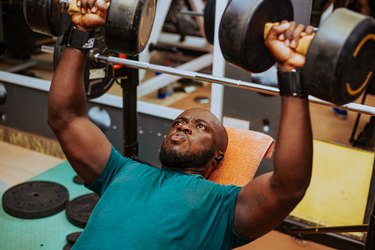
While you typically see people using a barbell or weight machines to work their chest muscles, here's a training tip: Switch those out for a pair of dumbbells.
"Dumbbells allow you to move each arm independently," says Henry Halse, personal trainer and founder of Halse Strength and Fitness. "If you do a barbell bench press, your hands have to work in sync. When they're allowed to move independently, you can correct imbalances in strength or even flexibility because one side can't rely on the other."
Video of the Day
Essentially, if your right arm is stronger than your left, you might not know if it you're lifting with a barbell. But with dumbbells, you'll be able to tell right away.
But there's a catch. "When you select dumbbells, always cater to the weaker arm," Halse says. "If you can only do 10 reps with 15 pounds on your left arm, but 10 reps with 20 pounds on your right, you should stick to 15 pounds to allow the left to catch up. This way, you can correct a strength imbalance by holding the right arm back."
When you're ready to trade in the pec deck for free weights, here are four dumbbell chest exercises for your next upper-body workout.
Tip
"Select a weight that's challenging for 8 to 12 reps," Halse says. "You don't need to do heavy weights for 1 or 2 reps, unless you plan on doing a weight-lifting competition."
1. Dumbbell Bench Press
- Lie on your back on a weight bench (or the floor) with a dumbbell in each hand. Hold the weights with straight arms above your chest. Plant your feet firmly on the floor and tighten your abs.
- Bend your elbows and lower the weights until they are in line with your chest.
- Press the weights back up over your chest.
Tip
"Before you do a pressing motion, try to find your body's natural way of moving," Halse says. "Stand in front of a wall and put both hands on it. Pretend the wall is your car, and your car is out of gas. Pretend you're pushing your car from the back. Note how far apart your hands are and how far your elbows flare out. That's your natural pressing motion, and you should use that same motion when you do any dumbbell press variation."
2. Dumbbell Decline Bench Press
- Plant your feet at the end of the decline bench and slowly lie down.
- Hold a dumbbell in each hand above your chest, wider than shoulder-distance apart.
- As you breathe in, bring the weights down slowly until they reach your lower chest.
- Pause for a second, then press the dumbbells back to start on an exhale, using your chest muscles to push the weight.
- Straighten your arms and squeeze your chest as you hold for a second, then repeat.
Tip
You can also do a single-arm decline bench press by doing all your reps on one side at a time or an alternating-arm decline bench press by switching off between arms with each rep.
3. Dumbbell Incline Bench Press
- Lie down on a bench at a slight incline. Plant your feet on the floor, directly under your knees and point your feet straight or angled out at 45 degrees.
- Hold a dumbbell in each hand above your chest, wider than shoulder-distance apart.
- Contract your glutes (but don't lift them off the bench) and drive your feet into the ground as you press the weights up and slightly back toward your face. Press until your elbows are straight.
- Lower the weights back down to your chest with control.
4. Dumbbell Fly
- Lie down on a bench (or the floor) holding a dumbbell in each hand directly over your chest.
- With a slight bend in your elbows, rotate your shoulders so your elbows point out to the sides and your palms face each other. This is the starting position.
- Lower the dumbbells to the sides of your chest in an arcing motion until you feel a mild stretch (not pull or pain) in your chest.
- Exhale as you reverse the motion and use your chest muscles to press the dumbbells back to start.
Tip
"Keep your elbows very slightly bent," Halse says. "Go as far down as you feel comfortable, then come back up. Stretching too far can lead to shoulder pain."